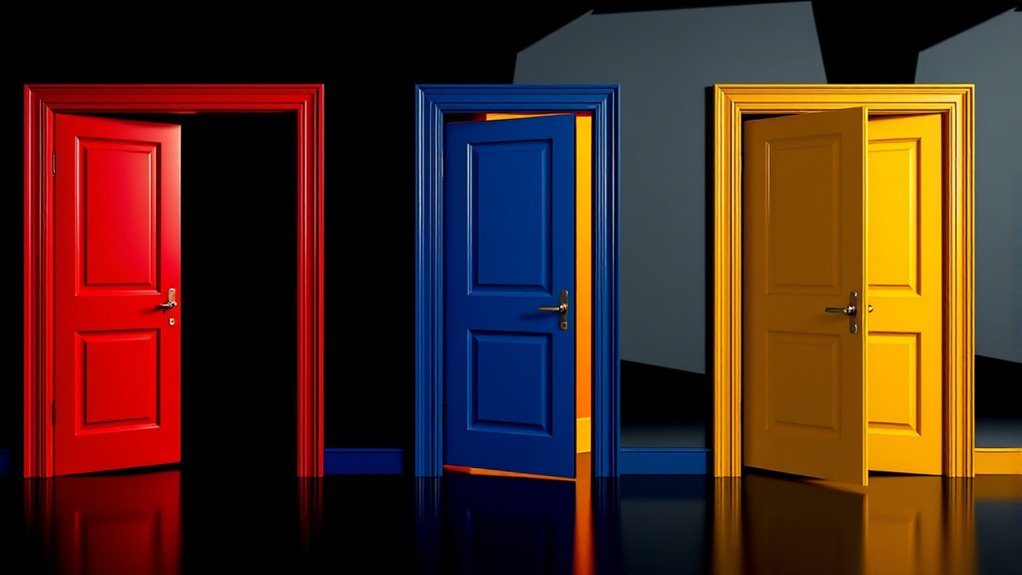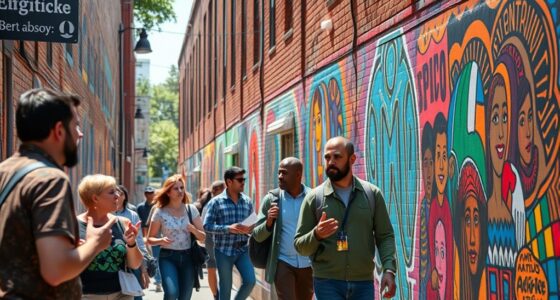Your intuition might tell you that switching doors in the Monty Hall problem doesn’t matter, but that’s wrong. When you first pick a door, there’s a one-third chance you’re right, and two-thirds you’re wrong. Monty’s reveal of an empty door actually shifts those odds in your favor if you switch, increasing your chances from one-third to two-thirds. To truly understand why your gut is misleading, keep exploring how this puzzle changes your perspective on probability.
Key Takeaways
- Intuition suggests equal odds after a door is opened, but initial probabilities favor switching due to the original 1/3 and 2/3 chances.
- Monty’s deliberate reveal provides crucial information, shifting the odds and making switching the more statistically advantageous choice.
- Our natural reasoning tends to treat the remaining doors as equally likely, ignoring how prior probabilities influence outcomes.
- The problem demonstrates how human intuition often misjudges probability because it overlooks the impact of new information.
- Recognizing the role of initial probabilities and the host’s knowledge clarifies why switching improves chances from 1/3 to 2/3.

The Monty Hall Problem is a famous puzzle that challenges your intuition about probability and decision-making. At first glance, it seems simple: you pick one of three doors, and if your choice has a prize behind it, you win. But the twist comes after you make your initial selection. The host, Monty Hall, who knows what’s behind each door, opens one of the remaining two doors that he knows is empty. Now, he offers you the chance to switch your choice to the other unopened door. Your instinct might tell you that staying or switching doesn’t matter, each having a 50-50 shot. However, this isn’t the case, and understanding why involves diving into probability puzzles and decision strategies that often defy your gut feeling.
Initially, your chance of picking the winning door is 1 in 3, meaning there’s a 2 in 3 chance the prize is behind one of the other two doors. When Monty opens a door that he knows reveals no prize, he isn’t randomly opening a door—he’s actively providing information. If your original choice was wrong—which has a 2 in 3 probability—then switching will guarantee a win, because the remaining unopened door must have the prize. Conversely, if your initial choice was right (1 in 3 chance), switching would lead to a loss. This means that by switching, your probability of winning increases from 1/3 to 2/3, a counterintuitive result that many find confusing at first.
This problem highlights how decision strategies should be based on probability, not intuition. Many people fall into the trap of thinking the odds are equal once one door is opened, but that’s not true. Instead, you need to recognize that your initial choice had a lower probability of success, and the host’s action of revealing a non-winning door provides pivotal information that skews the odds in favor of switching. It’s a perfect example of how probability puzzles can reveal flaws in our natural decision-making processes. By understanding the underlying statistics, you can make smarter choices, even in situations that seem straightforward but are actually quite complex. For instance, home theatre projectors often require understanding contrast ratios and color accuracy to optimize your viewing experience, illustrating how critical accurate information is for making the right choice. The Monty Hall Problem teaches you that sometimes, the best decision strategy isn’t what your intuition suggests but what the probabilities indicate after carefully analyzing the information available.
Frequently Asked Questions
Can the Monty Hall Problem Be Applied to Real-Life Decision Making?
You can definitely apply the Monty Hall problem to real-life decision making, as it highlights how decision making biases and risk assessment can be flawed. When faced with choices, you might stick to your initial instinct instead of re-evaluating, leading to subpar outcomes. Understanding this problem helps you recognize when to reconsider your decisions, weigh risks better, and avoid common cognitive biases that hinder ideal decision making.
How Does Probability Change if There Are More Than Three Doors?
When more than three doors are involved, the probability distribution shifts as you eliminate doors. Initially, each door has an equal chance, but as you open and eliminate options, your chances of winning behind the remaining doors increase differently. You should re-evaluate the probabilities based on door elimination, understanding that the chance of choosing the correct door improves when you switch, but the overall distribution depends on the number of doors.
What Are Common Misconceptions About the Monty Hall Problem?
Think of misconceptions about the Monty Hall problem like fog obscuring your view; they block clear understanding. Many believe switching doors is a gamble or that probabilities are equal, but these are intuition errors and myth-like misconceptions. People often cling to faulty intuition, missing the fact that switching actually doubles your chances of winning. Recognizing these misconception myths helps you see through the fog and understand the true probability dynamics at play.
How Does Prior Knowledge Affect the Optimal Strategy?
Your prior knowledge influences your decision strategies considerably. If you understand the probability involved, you’re more likely to switch doors, increasing your chances of winning. Without this knowledge, your intuition may lead you to stick with your initial choice. Recognizing how prior knowledge impacts your reasoning helps you make better, more informed decisions, especially in situations involving chance and uncertainty.
Are There Variations of the Problem in Different Cultures or Contexts?
Imagine a tapestry woven differently across cultures, each thread representing unique perspectives. You might find that cultural interpretations and contextual adaptations influence how people understand probability puzzles. In some societies, storytelling shapes intuition, altering decision-making. Variations of the problem arise through these cultural lenses, highlighting that interpretations change based on context. Recognizing this helps you see that the classic puzzle’s lessons aren’t universal but molded by diverse cultural nuances.
Conclusion
So, next time you face three doors, don’t trust your gut—your intuition might be more wrong than a compass in a tornado. The Monty Hall problem proves that even simple choices can defy common sense in mind-blowing ways. Embrace the math, switch doors, and watch your odds skyrocket like a rocket to the stars. Sometimes, logic is the only thing that can save you from the chaos of guesswork!









